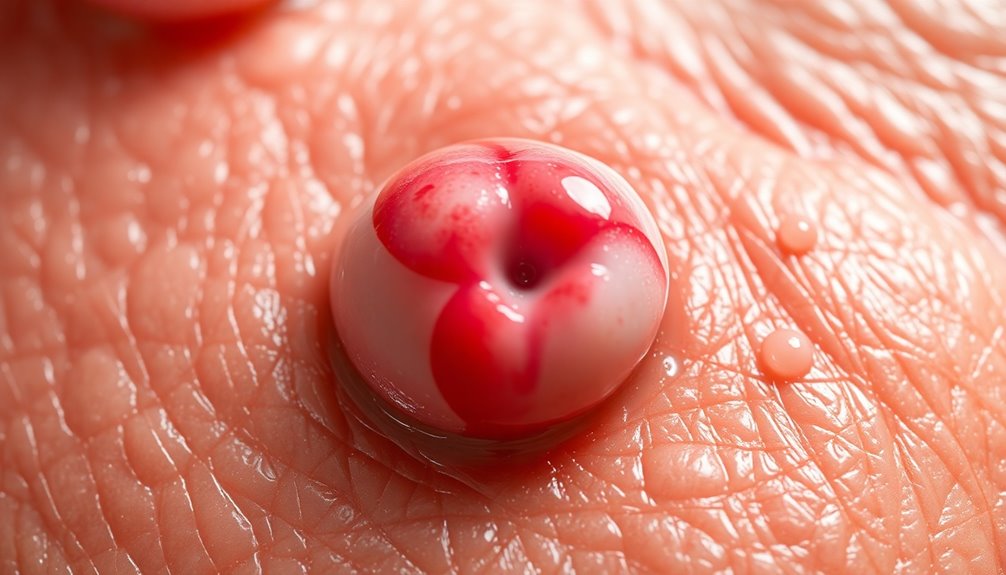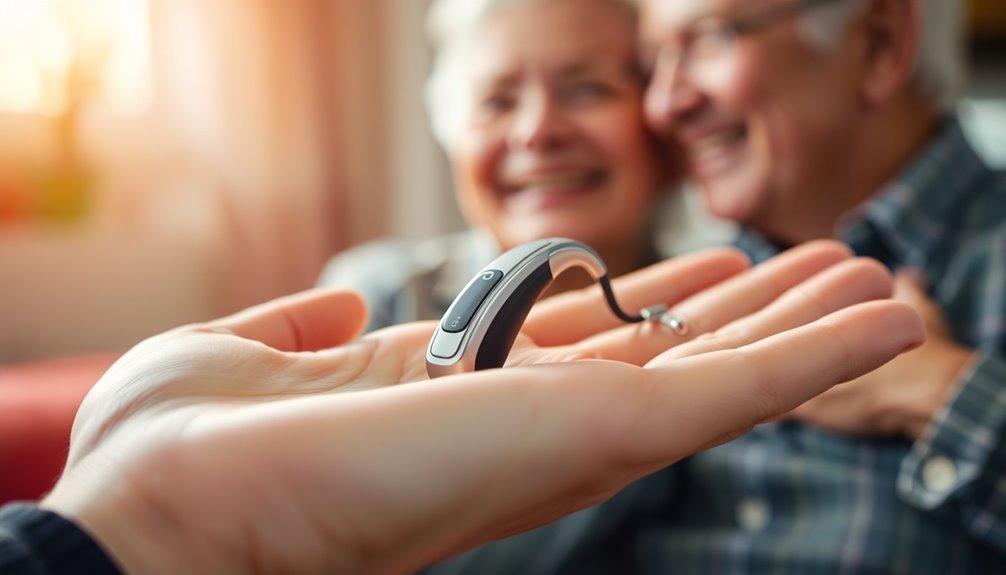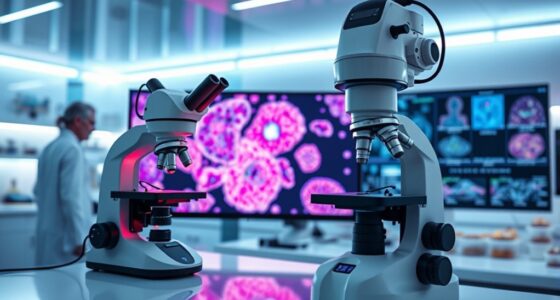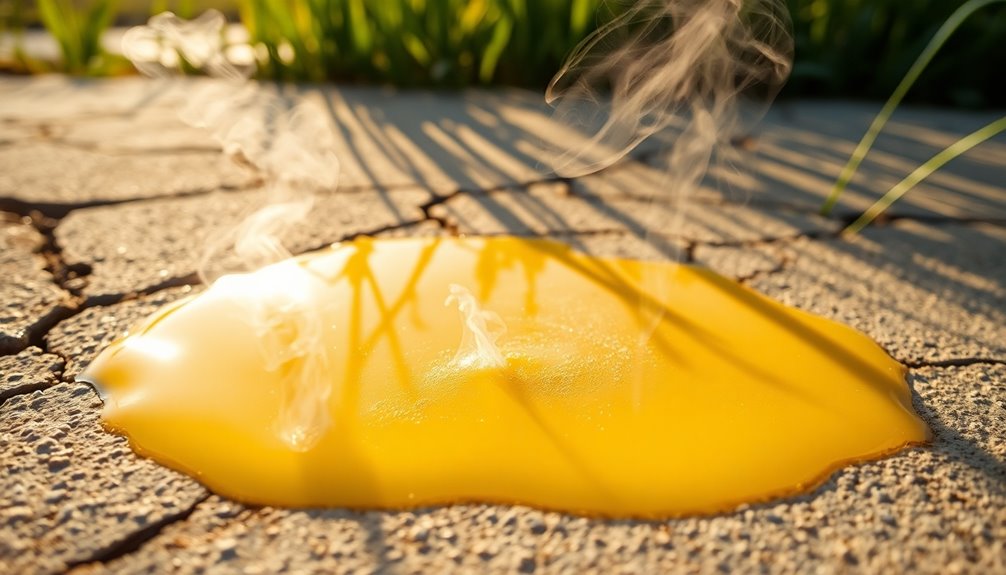Cysts, ear boils, and pimples are often confused, but they're quite different. Cysts are typically painless, fluid-filled sacs that can grow slowly and might require treatment if inflamed. Ear boils are painful, red bumps often due to bacterial infections, causing swelling and pus. Pimples, on the other hand, are small, inflamed spots linked to acne, usually caused by clogged pores. Recognizing these differences is essential for proper treatment and avoiding complications. If you want to know more about how to identify and manage these conditions effectively, you'll want to keep exploring the details.
Key Takeaways
- Cysts are typically painless, smooth lumps filled with fluid, while ear boils are painful, swollen, and often filled with pus due to infections.
- Pimples result from clogged pores and are usually small, inflamed spots associated with acne; they can be tender or painful.
- Ear boils commonly arise from bacterial infections and can lead to complications if untreated, while cysts are generally benign unless inflamed.
- Good hygiene and non-comedogenic products can help prevent pimples and boils, while cysts may require observation or surgical removal if symptomatic.
- Seek medical attention for persistent or painful lesions, as well as for multiple boils or pimples near sensitive areas, to avoid complications.
Understanding Cysts
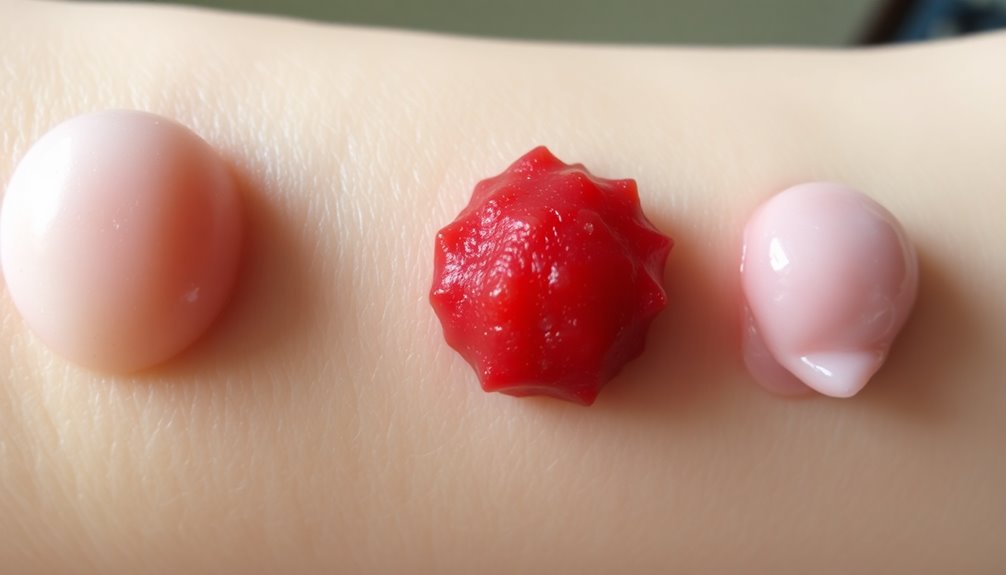
A cyst is a closed sac filled with fluid, air, or other material that can develop in various parts of your body. The most common types are epidermal and sebaceous cysts, which often appear as movable nodules on your neck, back, or face.
You might notice that these cysts are generally painless, but if they become large or inflamed, they can lead to discomfort and even skin discoloration. Cysts can arise from blocked ducts, genetic factors, hormonal changes, or infections and are more common after puberty.
When it comes to diagnosis, healthcare providers typically perform a visual examination to determine the nature of the cyst. They'll look for symptoms like tenderness or changes in size.
If a cyst becomes bothersome, treatment options include observation, drainage, or surgical removal. It's important to consult a healthcare provider if you notice any changes in your skin or if a cyst becomes inflamed. Additionally, some cysts may be related to dietary needs for optimal health, so it's essential to consider overall nutrition as part of your wellness plan.
Recognizing Ear Boils
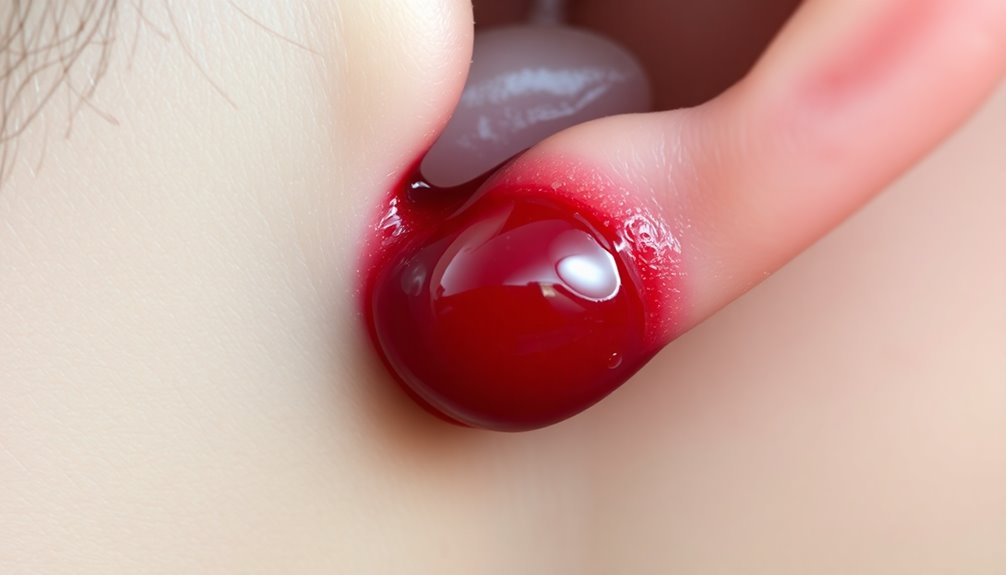
Recognizing ear boils starts with noticing the signs of infection. Typically, an ear boil is a painful, swollen, red bump that forms due to a bacterial infection, often caused by Staphylococcus aureus. These boils commonly appear on the outer ear, behind the ear, or along the ear canal, where hair follicles are present.
| Signs of Ear Boils | Symptoms | When to Seek Medical Attention |
|---|---|---|
| Redness | Pain | If it doesn't improve in 2 weeks |
| Swelling | Tenderness | Significant pain occurs |
| Development of pus | Fever (systemic signs) | Signs of spreading infection |
As the boil progresses, you may notice an accumulation of pus, leading to a white or yellow center. If you observe significant pain, persistent swelling, or any complications, it's essential to seek medical attention. Untreated ear boils can result in further issues, such as spreading bacteria or even the formation of a carbuncle. Always monitor your condition closely and take action if symptoms worsen.
Identifying Pimples
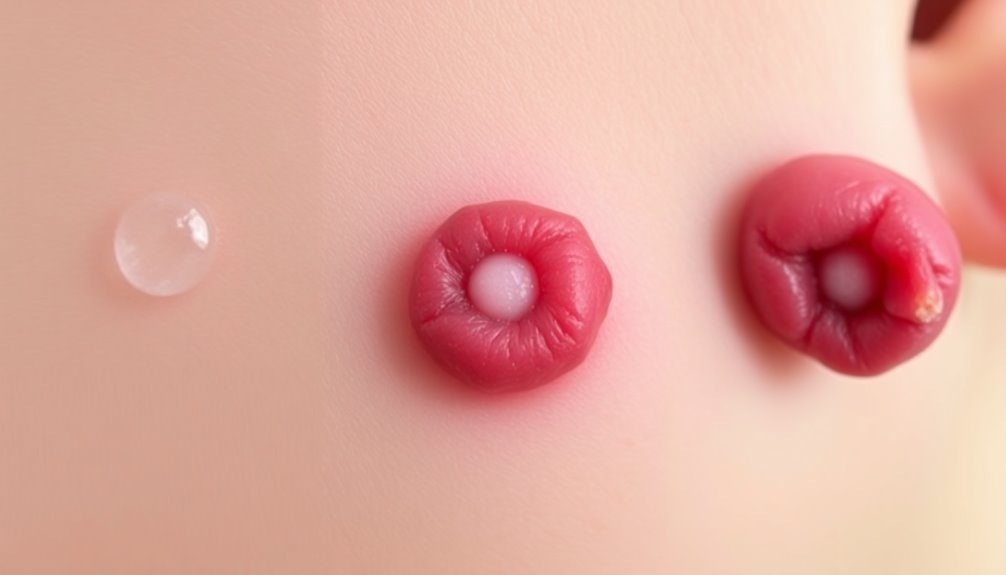
When you notice a pimple in or around your ear, it's often due to clogged pores caused by excess oil and bacteria.
Symptoms like redness and inflammation can signal an acne flare-up, which may be triggered by hormonal changes or stress.
Knowing the causes and signs can help you address these pesky pimples effectively.
Causes of Ear Pimples
Many people experience ear pimples, which often arise from clogged pores caused by excess oil, dead skin cells, and bacteria. These factors are similar to those seen in acne on other parts of your body. Hormonal changes, especially during puberty, can trigger an uptick in oil production, leading to pimples in the ear area.
Genetics also play a significant role; some individuals are more prone to acne and related issues, including ear pimples. If your family has a history of skin problems, you might be at a higher risk.
Poor hygiene practices can further exacerbate the situation. Not regularly cleaning your earbuds or the ear area can increase the likelihood of developing pimples.
Additionally, stress is known to contribute to various skin issues, which may increase the occurrence of pimples in sensitive areas like the ears.
Symptoms to Watch For
Pimples in the ear often start as small, red bumps that can be tender to the touch. These pimples develop due to inflammation and typically indicate an overproduction of oil in the skin.
You'll notice symptoms like clogged pores filled with oil and dead skin, leading to whiteheads, blackheads, or papules. Hormonal changes, especially during puberty, can exacerbate this oil production, resulting in more frequent breakouts.
Stress is another factor that might trigger or worsen your pimples, increasing inflammation and oil production in your skin.
It's important to keep an eye on these symptoms, as untreated pimples can develop into more severe forms, like cysts or boils. While pimples can appear anywhere, they're most common in areas with high concentrations of oil glands, such as your face, back, chest, and shoulders.
If you notice persistent or painful bumps, consider seeking treatment to prevent further complications. Recognizing the symptoms early can help you manage the condition more effectively and maintain healthier skin. Additionally, using hydrocolloid patches can aid in the speedy recovery of these pimples by drawing out impurities and promoting healing.
Symptoms Comparison

When you're trying to identify whether you have a cyst, boil, or pimple, it's essential to recognize their distinct symptoms.
Cysts are usually painless and smooth, while boils are painful and swollen, often filled with pus.
Pimples, on the other hand, typically show up as small, inflamed red spots, often linked to acne.
Cyst Symptoms Overview
Understanding the differences between cysts and boils can help you identify what you're dealing with. Cysts usually present as smooth, painless lumps beneath the skin, while boils are red, swollen, and tender, often filled with pus. Here's a quick comparison of their symptoms:
| Cysts | Boils |
|---|---|
| Typically painless | Painful and tender |
| Slow-growing | Rapidly developing |
| Generally benign | Can lead to infections |
| May show skin discoloration | Red, swollen areas |
| Treatment may not be needed | Often requires medical treatment |
Cysts can vary in size and might resolve on their own, but if they become inflamed or infected, tenderness and swelling may occur. In contrast, boils can cause significant discomfort and may be accompanied by fever, indicating a possible infection. While cysts often don't require medical attention, boils usually need treatment such as antibiotics or even surgical drainage to prevent complications. Recognizing these symptoms is essential for proper care and to avoid further health issues.
Boil Symptoms Overview
Experiencing a boil can be uncomfortable and alarming, especially when trying to distinguish it from other skin issues like cysts or pimples.
Boils typically start as small, swollen red lumps that are often tender and painful to the touch. As they develop, you'll notice a white or yellow center forming, filled with pus. This is a key symptom that sets boils apart from cysts, which usually appear as painless, smooth lumps without any pus unless inflamed.
The surrounding skin of a boil often shows signs of redness and inflammation, indicating an infection. In contrast, cysts generally have normal-looking skin unless they become infected.
If a boil's infection spreads, you might experience systemic symptoms like fever and fatigue, which is uncommon for cysts unless they also become infected.
Boils can sometimes form in clusters, known as carbuncles, while cysts usually develop individually.
Understanding these symptoms can help you identify whether you're dealing with a boil or a cyst, enabling you to seek appropriate treatment for your skin concerns.
Pimple Symptoms Overview
Pimples often start as small, red bumps that can swell and become painful, sometimes developing a white or yellow center filled with pus. These symptoms are common indicators of a pimple. You might notice tenderness and possible itching, especially if they cluster together or appear as isolated spots on oily areas like your face, back, and shoulders.
Unlike cysts, which are typically painless and grow slowly, pimples can emerge quickly due to clogged pores, leading to inflammation and noticeable redness surrounding the bump.
When you touch or squeeze a pimple, it may ooze pus, which is a sign of infection. This pus is a buildup of dead skin cells, bacteria, and oil.
It's essential to note that fever isn't usually associated with pimples. If you experience a fever, it might indicate a boil or another type of infection that requires medical attention.
Causes and Risk Factors
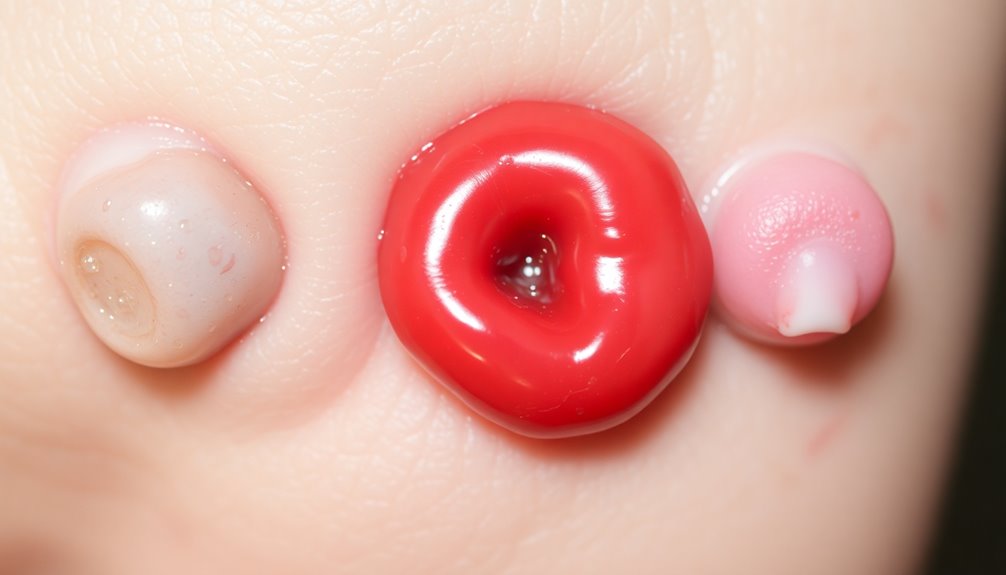
The formation of cysts, boils, and pimples can stem from a variety of causes and risk factors that influence your skin's health. Cysts often develop due to blocked ducts, genetic factors, or infections. For women, hormonal changes play a vital role in their formation, especially during menstruation.
Boils, on the other hand, are primarily caused by bacterial infections, particularly Staphylococcus aureus, which can enter through broken skin or hair follicles. Risk factors for boils include poor hygiene and a compromised immune system.
Earlobe cysts, known as epidermoid cysts, arise from trapped epidermis cells, typically linked to damaged hair follicles or oil glands. These cysts are more common in individuals post-puberty.
Pimples form when excess oil, dead skin cells, and bacteria clog your pores. Hormonal changes during puberty greatly increase oil production, which can lead to more pimples.
If you have a history of acne or other skin conditions, you're at a higher risk for developing cysts, boils, or pimples. Additionally, genetic predisposition can further contribute to your susceptibility, making it essential to understand these causes and risk factors for better skin health management.
Diagnosis Methods

Diagnosing cysts, boils, and pimples involves a straightforward process that typically starts with a visual examination by your healthcare provider.
They'll assess the appearance of the lump and discuss your symptoms, which is essential for an accurate diagnosis. For cysts, the focus is usually on the characteristics of the lump, while boils might require more specific tests.
If your healthcare provider suspects a boil, they may perform culture tests on the pus to identify the bacteria causing the infection, commonly Staphylococcus aureus.
In some cases, particularly with larger cysts, imaging tests like ultrasound or MRI can help evaluate the contents and determine the best course of action.
Although a biopsy is rarely necessary for cysts or boils, it may be conducted if there's a suspicion of malignancy in unusual cases.
Dermatologists often play a key role in this process, as they'll not only perform a visual examination but also ask about your treatment attempts and the surrounding skin condition to aid in the diagnosis.
This thorough approach guarantees you receive the proper evaluation for your condition. Additionally, maintaining a clean environment, including using an air purifier to reduce allergen reduction, can support skin health and minimize irritation.
Treatment Options

When it comes to treating cysts, ear boils, and pimples, the approach varies based on the condition's specifics and severity. Each requires different treatment options to guarantee effective healing and avoid complications.
1. Cysts: For benign cysts, observation is often sufficient. If they become symptomatic, you might need drainage or surgical removal. Regular dental check-ups can also help identify any related issues that may arise from skin conditions.
Always consult a healthcare professional if you notice signs of infection.
2. Boils: Home treatment usually includes warm compresses to promote drainage. If the boil is severe or shows signs of infection, antibiotics or surgical drainage may be necessary.
Don't hesitate to seek medical consultation if pain persists.
3. Pimples: A consistent skincare routine can work wonders. Use products containing benzoyl peroxide or salicylic acid to reduce oil and bacteria on your skin.
If persistent, a visit to a dermatologist may be advisable for specialized treatment.
In all cases, avoid popping or squeezing, as this can lead to further infection or complications.
Addressing these conditions promptly and effectively is key to your skin health.
Prevention Strategies
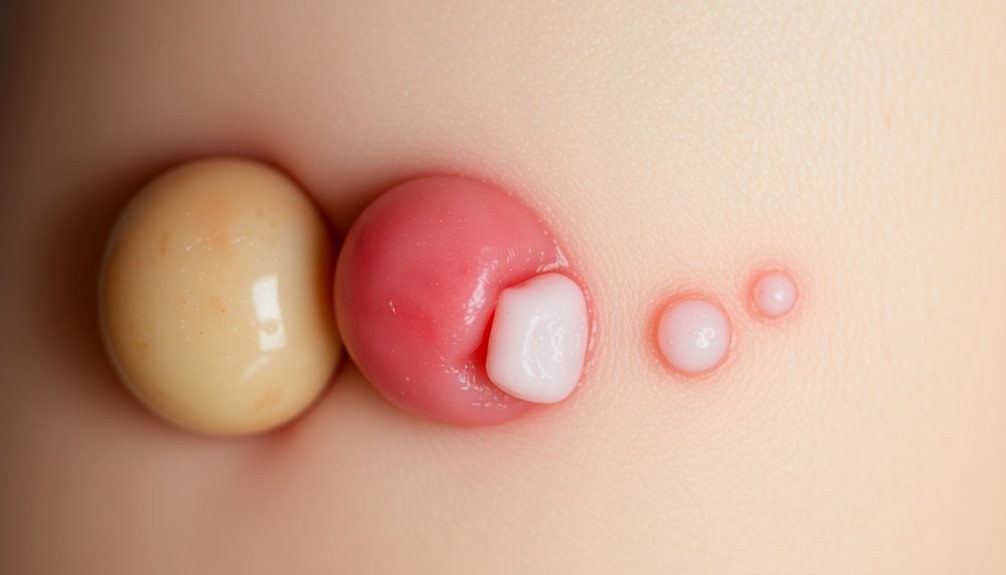
Preventing cysts, ear boils, and pimples involves adopting effective strategies that promote healthy skin. By focusing on hygiene practices and your overall lifestyle, you can greatly reduce your risk of developing these skin issues.
| Prevention Strategy | Key Benefits | Recommended Actions |
|---|---|---|
| Good Hygiene Practices | Reduces infections and acne | Wash your face and ears daily |
| Non-Comedogenic Products | Prevents clogged pores | Choose skincare and hair products that won't clog pores |
| Balanced Diet | Supports skin health | Incorporate vitamins and antioxidants in your meals |
Incorporating stress management techniques, like exercise or mindfulness, can help balance hormones that contribute to acne formation. Keeping personal items, such as towels and earbuds, clean minimizes the risk of bacterial infections. Finally, a balanced diet rich in vitamins and antioxidants not only nourishes your body but also supports your skin's health, keeping cysts and pimples at bay. By implementing these strategies, you'll foster a clearer complexion and a more confident you! Additionally, engaging in low-impact exercises can also promote overall skin health and contribute to a balanced lifestyle.
When to Seek Help
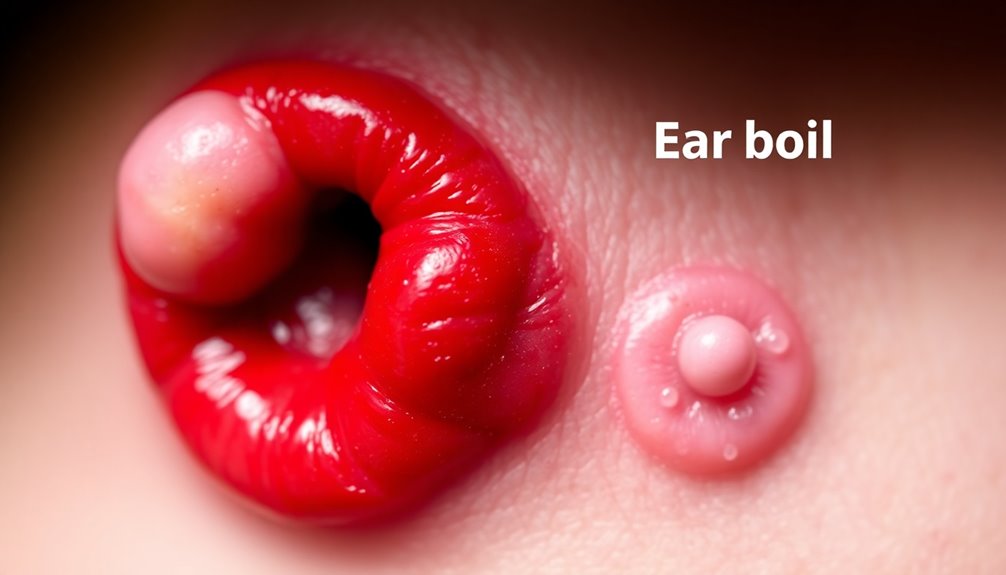
Knowing when to seek help for cysts, ear boils, or pimples can make a considerable difference in your skin health.
It's crucial to recognize the red flags that indicate you need medical advice. Here are three key situations to reflect upon:
- Persistent issues: If a boil or cyst doesn't improve within two weeks, it may signal a persistent infection that requires treatment from a healthcare professional.
- Severe symptoms: Contact a healthcare professional if you experience fever, increased swelling, or severe pain, as these symptoms could indicate that the infection is spreading.
- Multiple lesions: If you notice multiple boils or pimples, especially near sensitive areas like your eyes, seek immediate medical attention to prevent complications.
For ear cysts or pimples that become painful, change color, or grow considerably, don't hesitate to consult a doctor.
Persistent or worsening skin issues, such as recurring ear pimples, should be evaluated by a dermatologist. They can help determine underlying causes and recommend appropriate treatment to manage your skin health effectively.
Frequently Asked Questions
How to Tell the Difference Between a Cyst and a Boil on Earlobe?
To tell the difference between a cyst and a boil on your earlobe, start by examining the characteristics.
If the lump is painless, smooth, and movable, it's likely a cyst.
However, if you notice redness, swelling, and pain, it's probably a boil, which can also feel warm to the touch.
Keep an eye on any changes; cysts usually stay the same, while boils can get worse and may require medical attention.
How Do You Tell if a Lump Is a Cyst or Pimple?
Imagine you're staring at a lump on your skin, unsure if it's a cyst or a pimple. To differentiate, check its characteristics.
If it's tender, red, and possibly has pus, it's likely a pimple. If it feels smooth, movable, and isn't painful, it might be a cyst.
Remember, cysts are often slow-growing and asymptomatic, while pimples flare up quickly.
When in doubt, it's best to consult a healthcare professional for clarity.
How to Tell the Difference Between a Boil and a Cyst?
To tell the difference between a boil and a cyst, you'll want to look for key signs.
A boil typically appears as a painful, red, swollen bump that might ooze pus, while a cyst feels smooth and movable, often without pain.
Boils can develop quickly and may cluster together, whereas cysts grow slowly and are usually painless.
If you're unsure, it's best to consult a healthcare professional for an accurate diagnosis.
What Is the Difference Between a Cyst and a Pimple in Your Ear?
When you notice a lump in your ear, it's essential to identify whether it's a cyst or a pimple.
Pimples arise suddenly and can be painful, often showing redness and swelling. In contrast, cysts grow slowly and usually don't hurt unless infected.
While pimples stem from clogged pores and bacteria, cysts often result from trapped skin cells.
Knowing the difference helps you choose the right treatment and address any concerns effectively.
Conclusion
Cysts, ear boils, and pimples may seem similar, but understanding their differences is essential for effective treatment. While a cyst might linger silently beneath your skin, an ear boil can cause sharp pain that demands attention. On the other hand, a pimple often pops up unexpectedly, leaving you feeling self-conscious. By recognizing these distinctions and knowing when to seek help, you can take control of your skin health and choose the right path to healing.
